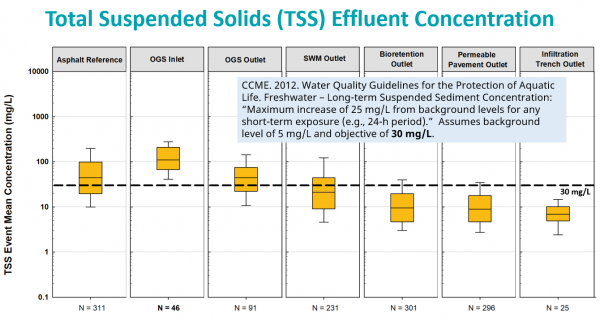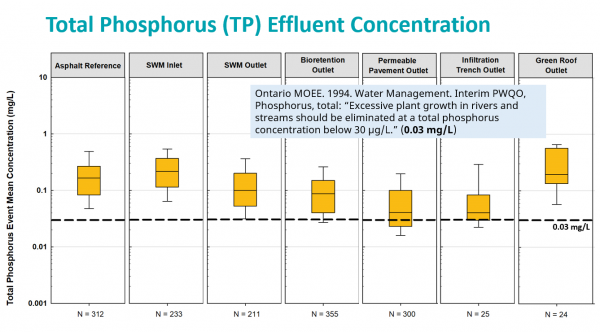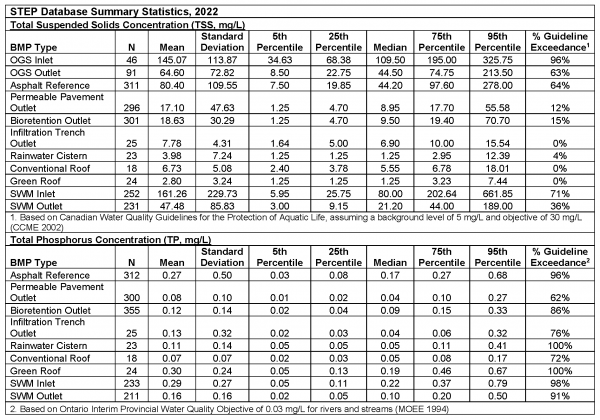Difference between revisions of "Water quality"
Jenny Hill (talk | contribs) |
Dean Young (talk | contribs) |
||
| (26 intermediate revisions by 3 users not shown) | |||
| Line 1: | Line 1: | ||
| − | |||
{{TOClimit|2}} | {{TOClimit|2}} | ||
| − | + | ==Overview== | |
| − | + | Improvements in the quality of stormwater runoff is one of the primary benefits of low impact development strategies. Although some chemical changes occur inside the practices, much of the pollution reduction of low impact development strategies comes from runoff reduction. i.e. diverting excess water through [[infiltration]] or [[evapotranspiration]]. | |
| − | |||
| − | |||
| − | + | ==Nutrients== | |
| − | + | Plants (including algae) require three macro nutrients to grow: Nitrogen, potassium, and phosphorus. See [[Nutrients]] page for more information about nutrients. Of these three, phosphorus is the often the "growth-limiting" nutrient (i.e., the local environment may have an abundance of nitrogen and potassium, but algae won't develop unless phosphorus is available too). | |
| − | + | See [[Phosphorus]] page for more information about phosphorus. See [[Additives]] page for guidance on [[Bioretention: Filter media| filter media]] additives to enhance retention of phosphorus and other types of pollutants in [[Bioretention]], [[Bioswale]], [[Stormwater Planter]] and [[Stormwater Tree Trenches| Stormwater Tree Trench]] facilities. | |
| − | + | [[File:TSS_effluent_comparison.png|thumb|600px|Under the CCME Water Quality Guidelines for the Protection of Aquatic Life. Freshwater – Long-term Suspended Sediment Concentration: “Maximum increase of 25 mg/L from background levels for any short-term exposure (e.g., 24-h period).” Assumes background level of 5 mg/L and objective of 30 mg/L total (CCME 2002)<ref>Canadian Council of Ministers of the Environment. 2002. Canadian water quality guidelines for the protection of aquatic life: Total | |
| − | + | particulate matter. In: Canadian environmental quality guidelines, 1999, Canadian Council of Ministers of the Environment, Winnipeg. https://ccme.ca/en/res/total-particulate-matter-en-canadian-water-quality-guidelines-for-the-protection-of-aquatic-life.pdf</ref>]] | |
| − | + | [[File:TP_effluent_comparison.png|thumb|600px|Under the Provincial Water Quality Objectives set out by the Ministry of Environment and Energy in 1994, Total phosphorus effluent leaving a SWM facility should be below a concentration level of 30 μg/L. (0.03 mg/L) (MOEE 1994)<ref>Ministry of the Environment and Energy. 1994. WATER | |
| − | < | + | MANAGEMENT POLICIES GUIDELINES - PROVINCIAL WATER QUALITY OBJECTIVES OF THE MINISTRY OF ENVIRONMENT AND ENERGY. July, 1994. Reprinted February 1999. ISBN 0-7778-8473-9 rev. https://dr6j45jk9xcmk.cloudfront.net/documents/3016/moeprovincialwaterqualityobjectivesen.pdf</ref>]] |
| − | + | [[File:STEPTSSTPsummarystats2022.png|thumb|600px|STEP Database Summary Statistics, TSS and TP concentrations, 2022.]] | |
| − | < | + | ===STEP stormwater practice effluent quality monitoring results=== |
| − | </ | + | The box plot figures to the right show stormwater effluent quality monitoring results from STEP monitoring projects conducted over a 25-year time period (between 1997 and 2021) at sites within Greater Toronto Area municipalities.<br> |
| − | + | <br> | |
| − | + | Median concentrations of Total Suspended Solids (TSS) in untreated stormwater and [[Oil and Grit Separator]] (OGS) outlet locations were found to exceed the Canadian Water Quality Guideline of 30 mg/L. Median TSS concentrations at stormwater detention pond and chamber system outlet locations were found to be below 30 mg/L, but exceeded the guideline value in 36% of the 231 monitored storm events. Median TSS concentrations at bioretention, permeable pavement and infiltration trench outlet locations were found to be all below 30 mg/L. TSS concentrations in effluent from bioretention was found to exceed 30 mg/L in only 15% of the 301 monitored storm events, and in only 12% of the 296 monitored events for permeable pavements.<br> | |
| − | < | + | <br> |
| − | < | + | Median concentrations of Total Phosphorus (TP) in untreated stormwater and all stormwater treatment facility type outlet locations were found to exceed the Ontario Provincial Water Quality Objective of 0.03 mg/L. Untreated stormwater was found to exceed 0.03 mg/L in between 96 to 98% of the 545 monitored storm events (Asphalt Reference and SWM Inlet data sets). Stormwater detention pond or chamber system effluent was found to exceed 0.03 mg/L during 91% of the 211 monitored events. Effluent from bioretention outlet locations was found to exceeded 0.03 mg/L during 86% of the 355 monitored events. Effluent from permeable pavement outlet locations exceeded 0.03 mg/L during 62% of the 300 monitored storm events.<br> |
| − | + | <br> | |
| − | < | + | It is notable that green roof and infiltration trench results are from only one site each, and based on a relatively small number of storm events (24 to 25). |
| − | < | ||
| − | < | ||
| − | < | ||
| − | |||
| − | + | Click on the links below for LID BMP-specific treatment performance sections for more figures and information on water quality treatment performance. | |
| − | + | ||
| − | + | *[[Bioretention#Water_Quality| Bioretention Performance]] | |
| − | + | *[[Permeable pavements#Water_Quality| Permeable Pavements Performance]] | |
| − | + | ||
| − | ===External Links== | + | ==Heavy metals== |
| − | + | {{:Heavy metals}} | |
| − | + | ||
| − | + | ==External Links== | |
| − | + | *[https://www.ec.gc.ca/grandslacs-greatlakes/default.asp?lang=En&n=6201FD24-1 Environment Canada on Phosphorus and Excess Algal Growth ] | |
| − | + | *[https://www.ontario.ca/page/lake-simcoe-phosphorus-reduction-strategy Lake Simcoe phosphorus reduction strategy] | |
| − | + | *[https://stepapps.shinyapps.io/WQ_Interactive4/ Canadian BMP Water Quality Database] | |
| − | + | ||
| − | + | ==References== | |
Latest revision as of 16:10, 1 May 2023
Overview[edit]
Improvements in the quality of stormwater runoff is one of the primary benefits of low impact development strategies. Although some chemical changes occur inside the practices, much of the pollution reduction of low impact development strategies comes from runoff reduction. i.e. diverting excess water through infiltration or evapotranspiration.
Nutrients[edit]
Plants (including algae) require three macro nutrients to grow: Nitrogen, potassium, and phosphorus. See Nutrients page for more information about nutrients. Of these three, phosphorus is the often the "growth-limiting" nutrient (i.e., the local environment may have an abundance of nitrogen and potassium, but algae won't develop unless phosphorus is available too). See Phosphorus page for more information about phosphorus. See Additives page for guidance on filter media additives to enhance retention of phosphorus and other types of pollutants in Bioretention, Bioswale, Stormwater Planter and Stormwater Tree Trench facilities.


STEP stormwater practice effluent quality monitoring results[edit]
The box plot figures to the right show stormwater effluent quality monitoring results from STEP monitoring projects conducted over a 25-year time period (between 1997 and 2021) at sites within Greater Toronto Area municipalities.
Median concentrations of Total Suspended Solids (TSS) in untreated stormwater and Oil and Grit Separator (OGS) outlet locations were found to exceed the Canadian Water Quality Guideline of 30 mg/L. Median TSS concentrations at stormwater detention pond and chamber system outlet locations were found to be below 30 mg/L, but exceeded the guideline value in 36% of the 231 monitored storm events. Median TSS concentrations at bioretention, permeable pavement and infiltration trench outlet locations were found to be all below 30 mg/L. TSS concentrations in effluent from bioretention was found to exceed 30 mg/L in only 15% of the 301 monitored storm events, and in only 12% of the 296 monitored events for permeable pavements.
Median concentrations of Total Phosphorus (TP) in untreated stormwater and all stormwater treatment facility type outlet locations were found to exceed the Ontario Provincial Water Quality Objective of 0.03 mg/L. Untreated stormwater was found to exceed 0.03 mg/L in between 96 to 98% of the 545 monitored storm events (Asphalt Reference and SWM Inlet data sets). Stormwater detention pond or chamber system effluent was found to exceed 0.03 mg/L during 91% of the 211 monitored events. Effluent from bioretention outlet locations was found to exceeded 0.03 mg/L during 86% of the 355 monitored events. Effluent from permeable pavement outlet locations exceeded 0.03 mg/L during 62% of the 300 monitored storm events.
It is notable that green roof and infiltration trench results are from only one site each, and based on a relatively small number of storm events (24 to 25).
Click on the links below for LID BMP-specific treatment performance sections for more figures and information on water quality treatment performance.
Heavy metals[edit]
The heavy metals noted as particularly harmful to aquatic ecosystems are:
- Chromium(Cr),
- Copper (Cu),
- Lead (Pb), and
- Zinc (Zn)[3]
Laboratory experiments on bioretention media have demonstrated that the organic matter significantly improves retention of lead (Pb), copper (Cu), and zinc (Zn) [4]. This research also found that extended detention of the stormwater in the cell did not improve this water quality benefit.
Cores of media were extracted from five 10 year old bioretention cells in Queensland, Auz and tested for a suite of heavy metals: “Although trace amounts of several heavy metals (most prominently Mn and Zn) were found in most of the basins, all heavy metal levels found in the soil were either below detectable limits, or within acceptable limits based on legislated health-based investigation levels.”[5]
External Links[edit]
- Environment Canada on Phosphorus and Excess Algal Growth
- Lake Simcoe phosphorus reduction strategy
- Canadian BMP Water Quality Database
References[edit]
- ↑ Canadian Council of Ministers of the Environment. 2002. Canadian water quality guidelines for the protection of aquatic life: Total particulate matter. In: Canadian environmental quality guidelines, 1999, Canadian Council of Ministers of the Environment, Winnipeg. https://ccme.ca/en/res/total-particulate-matter-en-canadian-water-quality-guidelines-for-the-protection-of-aquatic-life.pdf
- ↑ Ministry of the Environment and Energy. 1994. WATER MANAGEMENT POLICIES GUIDELINES - PROVINCIAL WATER QUALITY OBJECTIVES OF THE MINISTRY OF ENVIRONMENT AND ENERGY. July, 1994. Reprinted February 1999. ISBN 0-7778-8473-9 rev. https://dr6j45jk9xcmk.cloudfront.net/documents/3016/moeprovincialwaterqualityobjectivesen.pdf
- ↑ Feng W, Hatt BE, McCarthy DT, Fletcher TD, Deletic A. Biofilters for Stormwater Harvesting: Understanding the Treatment Performance of Key Metals That Pose a Risk for Water Use. Environ Sci Technol. 2012;46(9):5100-5108. doi:10.1021/es203396f.
- ↑ Gülbaz S, Kazezyilmaz-Alhan CM, Copty NK. Evaluation of Heavy Metal Removal Capacity of Bioretention Systems. Water Air Soil Pollut. 2015;226(11). doi:10.1007/s11270-015-2640-y.
- ↑ Lucke T, Nichols PWB. The pollution removal and stormwater reduction performance of street-side bioretention basins after ten years in operation. Sci Total Environ. 2015;536:784-792. doi:10.1016/j.scitotenv.2015.07.142.
